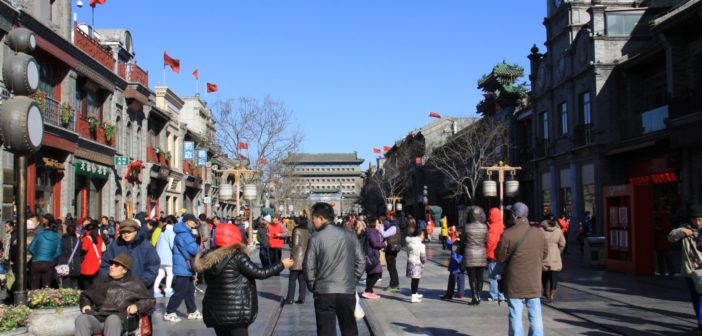Beijing has always been hailed as a historical hotspot with attractions such as the Temple of Heaven, Forbidden City, Summer Palace, the Great Wall, and more getting hordes of both domestic and international tourists flocking in to tick it off their must-see places.
For anyone interested in history and culture, these three lesser-known gems are worth checking out:
Dazhalan
Dazhalan 大栅栏, literally the “Great Fence,” has always been known as a busy market street. It’s 270 meters long and features 37 product and service stores. Dazhalan boasts specialty shops that have existed for hundreds of years, including Tongrentang Traditional Medicine Shop, which was opened in 1669; the old Juyuan Hat Shop, now called the Dongsheng Hat Shop, opened in 1811, and the famous Ruifuxiang Satin, Silk and Fur Shop, which opened in 1893.
During the Ming (1368–1644) and Qing (1644-1912) dynasties, night curfews were imposed and most streets and alleys had barriers (zhalan) built at both ends. According to historical records, there were 1,200 of these structures built and one of them was the Dazhalan. The original structures were destroyed in 1900 and rebuilt as what stands today.
Address: 44 Langfang Ertiao, Xicheng District, Beijing
Qianmen
Qianmen 前门, literally the “Front Gate,” is located in the central axis of Beijing and is 870 meters long. It was called Zhengyangmen Street during the Ming (1368–1644) and Qing (1644-1912) dynasties, and finally named Qianmen Street in 1965. In the Qing dynasty era, the area was a market that specialized in meat, cloth, and jewelry.
The street had a facelift in 2007 and was reopened on August 7, 2008, a day before the Beijing Olympics.Qianmen has local and international clothing brands, eateries, and souvenir shops. In 2014, the area got the internationally renowned Madame Tussauds Beijing, which features wax figurines of local and international celebrities, sport personalities, actors, and more.
Address: 16 Qianmen Street, Dongcheng District, Beijing
Niujie
Niujie, 牛街, literally translates to “Ox Street” and is home to the Hui people and Beijing’s largest concentration of Muslim people. The street’s main attraction is the Niujie Mosque, which was built in 996 during the Song Dynasty (960-1279), then rebuilt in 1442 after Genghis Khan’s armies destroyed it in 1215, and expanded in 1696 under the Qing (1644-1912) dynasty. It has an observation tower, prayer hall, and minaret (call to prayer tower) with a pavilion on each side. Visiting the mosque has to be arranged in advance especially during the months of Ramadan when people go more frequently to pray. Visitors must dress conservatively: long trousers or skirts, and shirts with sleeves are required.
By the time of the Qing dynasty, the neighboring markets were well known for halal beef and mutton. To this day the area has cafés, shops, restaurants, and schools catering to the Muslim population.
Address: 18 Niujie, Xuanwu District
Photo: Ctrip.com





3 Comments
We went to 牛街 about a month ago and it definitely has the best Muslin restaurants! The street is filled with wholesale vendors and butchers (think RMB 25 shaokao grills and raw lamb skewers), and would be worth the trip just for the meat!
This sounds like a meat-lover’s ideal street!
Jessica – sounds awesome! I haven’t been to any of the streets. I’ve got my eye on Dazhalan.